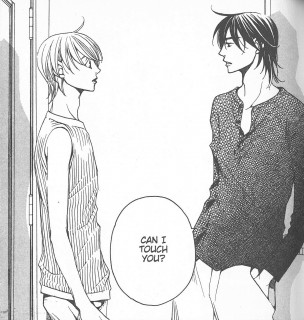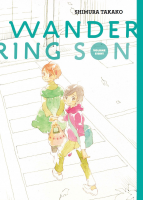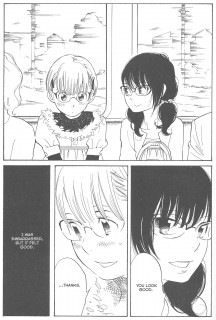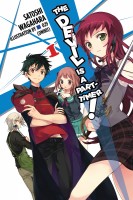 Author: Satoshi Wagahara
Author: Satoshi Wagahara
Illustrator: 029
Translator: Kevin Gifford
U.S. publisher: Yen Press
ISBN: 9780316383127
Released: April 2015
Original release: 2011
Awards: Dengeki Novel Prize
The Devil Is a Part-Timer! began in 2011 as a light novel series written by Satoshi Wagahara with illustrations by 029, but it has since expanded to include an anime adaptation and multiple manga series as well. I was actually introduced to The Devil Is a Part-Timer! through the 2013 anime series directed by Naoto Hosoda. I rather enjoyed it and so when Yen Press licensed not only the manga but the orignal light novel series of The Devil Is a Part-Timer!, it caught my attention. I was particularly interested in reading the anime’s source material, currently an ongoing series of novels at fourteen volumes in Japan. The Devil Is a Part-Timer!, Volume 1, which earned Wagahara a Silver Dengeki Novel Prize, was released in English in 2015 under Yen Press’ new light novel imprint Yen On with a translation by Kevin Gifford. The volume also includes color pages and an end-of-book bonus—character files in the form of a collection of resumes.
Satan, the Devil King, had one simple goal: to conquer Ente Isla and subjugate the humans there who manage to survive the invasion of his forces. All was going well until the Hero made her appearance on the battlefield. Emilia throws the Devil King’s plans into disarray and Satan is forced to make a hasty retreat along with Alciel, his strategist and one of the Four Great Demon Generals. Unintentionally, they end up in the parallel world of modern-day Japan with no immediate way back to Ente Isla. Emilia isn’t far behind them, which only causes another set of problems to deal with. Until they can return to their own world, Satan, now known as Maou, and Alciel, now known as Ashiya, must survive in this one as humans with very little access to their demonic powers. But then Maou secures a job as a part-timer at a fast food joint. He’s convinced that this will be the first step in conquering Japan, the world, and (assuming they can figure out how to get home) Ente Isla.
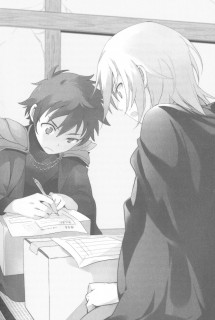 The first volume of The Devil Is a Part-Timer! and at least some if not all of the second were adapted as part of the anime series, so there were no real surprises for me plot-wise reading it. The novel does include a few more worldbuilding and character details, but for the most part the anime was a very straightforward, routine interpretation of Wagahara’s orignal story. The writing in The Devil Is a Part-Timer! isn’t particularly flashy, stylish, or clever—it’s more functional than anything else—but all of the characters have their own ways of speaking and expressing themselves. It’s immediately apparent who’s responsible for any given line of dialogue because they each have a unique, individual voice. As for the plot, it’s intentionally ridiculous and absurd, which to some extent is what makes The Devil Is a Part-Timer! entertaining. Admittedly, it sometimes doesn’t make a whole lot of logical sense, and there seem to be a few potential plot holes left for Wagahara to address as well, but the novel can still be legitimately fun. High literature it certainly isn’t, though, something that both Wagahara and the characters are well-aware of; the story developments in The Devil Is a Part-Timer!, Volume 1 are repeatedly compared to those of a B movie.
The first volume of The Devil Is a Part-Timer! and at least some if not all of the second were adapted as part of the anime series, so there were no real surprises for me plot-wise reading it. The novel does include a few more worldbuilding and character details, but for the most part the anime was a very straightforward, routine interpretation of Wagahara’s orignal story. The writing in The Devil Is a Part-Timer! isn’t particularly flashy, stylish, or clever—it’s more functional than anything else—but all of the characters have their own ways of speaking and expressing themselves. It’s immediately apparent who’s responsible for any given line of dialogue because they each have a unique, individual voice. As for the plot, it’s intentionally ridiculous and absurd, which to some extent is what makes The Devil Is a Part-Timer! entertaining. Admittedly, it sometimes doesn’t make a whole lot of logical sense, and there seem to be a few potential plot holes left for Wagahara to address as well, but the novel can still be legitimately fun. High literature it certainly isn’t, though, something that both Wagahara and the characters are well-aware of; the story developments in The Devil Is a Part-Timer!, Volume 1 are repeatedly compared to those of a B movie.
Very little of The Devil Is a Part Timer!, Volume 1 has much to do with magic or mayhem. Eventually Wagahara builds up to it for the volume’s finale, but for the most part the novel is surprisingly mundane. In the end, the crises that Maou is most concerned about is the possibility of being late for work. It seems likely that Maou and Ashiya’s personalities have significantly changed along with the changes in their physical forms. But then the humor in The Devil Is a Part-Timer! is largely derived from the characters being not at all who one would assume them to be and behaving in ways that are stunningly ordinary, especially considering their epic origins. Occasionally they do recall their quests—the demons’ goal to take over Ente Isla and Emilia’s desire to destroy Satan and his cohorts—but overall Maou appears to be content in his new-found work, Ashiya has come to accept his role of househusband, and even Emi has made a nice life for herself in Japan. Ultimately that’s what makes The Devil Is a Part-Timer so amusing, the complete mismatch between the characters as they are and the expectations of who they should be.


